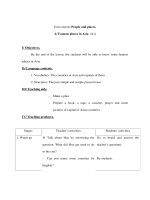4 12 floridas people and traditions
Bạn đang xem bản rút gọn của tài liệu. Xem và tải ngay bản đầy đủ của tài liệu tại đây (2.79 MB, 10 trang )
Fascinating Facts
• Nearly 12,000 cigar makers in 200 factories
in Ybor City made almost 700 million cigars
a year.
• The Morikami Museum and Japanese
Gardens at Delray Beach is the only museum in
the United States dedicated to the culture
of Japan.
• In 1985 Florida’s state seal was changed
so that the Plains Indian woman on it was
a Seminole.
Genre
Nonfiction
Comprehension Skill
Draw Conclusions
Text Features
• Sidebar
• Map
• Captions
Scott Foresman Social Studies
ISBN 0-328-14882-2
ì<(sk$m)=bei ca< +^-Ä-U-Ä-U
In this book you will read about some of the
people in Florida and their traditions. You
will also read about why different groups
of people came to Florida and the cultural
traditions they brought with them.
Write to It!
Look up one of the festivals mentioned
in this book and write a newspaper
advertisement for it. In your advertisement,
describe the activities and types of food
that will be a part of the festival. Tell people
why they should come to the festival.
Vocabulary
cultural group
annual
Write your advertisement on a separate sheet
of paper.
heritage
Illustration
14 Joe McDermott
Photographs
Every effort has been made to secure permission and provide appropriate credit for photographic material. The publisher deeply
regrets any omission and pledges to correct errors called to its attention in subsequent editions.
Unless otherwise acknowledged, all photographs are the property of Scott Foresman, a division of Pearson Education.
Photo locators denoted as follows: Top (T), Center (C), Bottom (B), Left (L), Right (R) Background (Bkgd)
ISBN: 0-328-14882-2
Copyright © Pearson Education, Inc.
All Rights Reserved. Printed in the United States of America. This publication is protected
by Copyright, and permission should be obtained from the publisher prior to any prohibited
reproduction, storage in a retrieval system, or transmission in any form by any means,
electronic, mechanical, photocopying, recording, or likewise. For information regarding
permission(s), write to: Permissions Department, Scott Foresman, 1900 East Lake Avenue,
Glenview, Illinois 60025.
1 2 3 4 5 6 7 8 9 10 V0G1 14 13 12 11 10 09 08 07 06 05
Opener: ©Jared Lazarus/Miami Herald Publishing Company
3 ©Jeff Greenberg/Alamy Images
5 ©Jeff Greenberg/The Image Works, Inc.
6 ©Corbis
7 ©Dave G. Houser/CorbisEditorial Offices: Glenview, Illinois • Parsippany, New Jersey • New York, New York
9 ©Jeff Greenberg/Alamy Images
10 ©Morton Beebe/CorbisSales Offices: Needham, Massachusetts • Duluth, Georgia • Glenview, Illinois
11 ©Jeff Greenberg/The Image
Works,
Inc. • Sacramento, California • Mesa, Arizona
Coppell,
Texas
13 ©Richard T. Nowitz/Corbis
15 ©City of Jacksonville
How History and
Culture Connect
Florida is home to people of different cultural
backgrounds. Look at Florida’s history to understand
why Florida does not have just one culture.
Some people came to Florida to explore it. Some
were brought to Florida and stayed to make it their
home. Others came to Florida because they wanted
a better life. Today people often move to Florida
because of its warm weather. Each cultural group
helps make Florida an interesting place to live and
visit.
3
Early Settlers
Native Americans arrived in Florida about ten
thousand years ago. When Spanish explorers
arrived during the 1500s, they discovered three
major Native American groups: the Calusa, the
Apalachee, and the Timicua.
The Seminole
Seminole beads are sold at the Indian Arts Festival.
After the arrival of European explorers, many
Native Americans died from disease and from
fighting in wars. Those who survived joined to form
a new group: the Seminole. The Seminole are a
mixture of different Native American groups.
In the early 1900s the Seminole lived in small
camps in the wetlands of southern Florida. They
were able to survive by hunting, fishing, and
trapping.
In 1934, the government passed the Indian
Reorganization Act. This act allowed Native
Americans to hold elections and form their own
governments. The Seminole wrote their own
constitution in 1957.
Today the Seminole have a strong economy.
They have their own school system and a museum.
Some of them live on reservations and others live in
towns or cities. They keep their culture alive through
storytelling, music, and crafts.
4
5
African Americans
African Americans have been a part of Florida’s
history and culture ever since Spanish explorers came
to Florida. During the Second Seminole War, many
former enslaved people found shelter among the
Seminole. During the Civil War many of the African
Americans who stayed in Florida took part in the
Battle of Olustee.
Two Important Writers
Two important African American
writers from Florida were Zora Neale
Hurston and James Weldon Johnson.
Zora Neale Hurston was an author
and anthropologist, or someone who
studies people and their cultures.
Hurston wrote about life in Florida’s African
American towns. James Weldon Johnson was a poet
and a lawyer who wrote the poem, “Lift Every Voice
and Sing.” It is known as the African American
national anthem.
6
These are the ruins of stone quarters for enslaved people.
After the Civil War ended, African Americans in
Florida lived in separate communities from other
people. In 1887 Eatonville became the first town in
Florida founded by African Americans.
The church was often a very important meeting
place in these communities. Churches held religious
services, political meetings, and cultural programs.
Some of these churches are still standing, and you
can see them on the Black Heritage Trail.
Florida Black Heritage Trail
The Florida Black Heritage Trail is a tour of
northeast Florida, it points out important places
in the lives of African Americans in the state.
Information about the trail is available at the visitors’
bureau in Jacksonville.
7
Cuba and Florida
Cuban Culture in Miami
When Spanish explorers arrived in Florida,
Cuba became a place where ships were built and
supplied. Cuba remained a Spanish territory, even
after Spain handed over Florida to the British in
1763. When Cubans fought for independence from
Spain in the late 1800s, many Cubans immigrated
to Florida. José Martí, the Cuban revolutionary,
traveled around Florida to gain support for
independence.
Cuban culture can be seen in Miami and southern
Florida. There are signs written in Spanish, and
a Spanish-language version of the Miami Herald.
Restaurants serve Cuban food. A man might be
seen wearing a guayabera (GUY-ah-bear-ah), a
Cuban-style embroidered shirt. Carnaval Miami
includes a big block party on a street called Calle
Ocho. This party is a well-known celebration of
Hispanic culture.
Revolution and Immigration
In 1959 a revolution in Cuba led by Fidel Castro
forced many Cubans to move to Florida. They settled
in a part of Miami that is known as Little Havana.
Cuban immigrants built a thriving community there.
8
Two men wearing guayaberas enjoy the sights and sounds of
Little Havana.
Caribbean Immigrants
People from islands in the Caribbean also call
Florida home. Florida is close to these islands.
Since 1971 about ten thousand Haitians
have immigrated to the United States. “Little
Haiti” in Miami is home to many Haitians and
other immigrants. Little Haiti is decorated like
a neighborhood in Haiti and has a Caribbean
marketplace too.
Parade goers dress in colorful costumes at the Goombay Festival.
People from the Bahamas immigrated to Florida
and formed a community in Coconut Grove
in 1840. The annual Goombay Festival is a
celebration of the Bahamian culture that brings in
many visitors. It began in the 1880s and is the
largest celebration of African heritage in the
United States.
The Caribbean Marketplace
is a market in Little Haiti.
11
British Farmers
Greek Immigrants
Great Britain gained control of Florida from Spain
in 1763. Many settlers from England, Scotland,
Ireland, and Wales moved there. They came from
the English colonies. Most of these people settled
in northern Florida. Before the Civil War, wealthy
farmers owned plantations. Enslaved people worked
for them on these plantations. Many other farmers,
however, hunted, raised cattle, and worked the land
themselves.
Greeks first came to Florida in 1768 and settled
New Smyrna Beach. Greek settlers later moved to
St. Augustine. Around 1850 many Greeks gathered
sponges in the Florida Keys. Sponges are simple
forms of water life whose skeletons form soft lumps
and are found on seabeds.
Thousands of Greek sponge fishers settled around
Tarpon Springs. Today many people visit Tarpon
Springs for the Greek culture and to watch the
divers pull sponges from the seabeds.
A diver holds sponges he found
while diving in Tarpon Springs.
12
Pensacola
World of
Nations
Celebration
Jacksonville
Crawfish
Creole
Festival
White
Springs
Florida Folk
Festival
Greek Festival
of Epiphany
International
Fringe Festival
Orlando
Tarpon Springs
Tampa
Gasparilla
Festival
Seminole
Tribal Fair
Ft. Myers
Hollywood
Florida Cultural
Celebrations
Latin Jazz
Festival
Key West
Miami
Goombay
Festival
Cuban
American
Heritage Festival
This map shows some of the cultural festivals that take place
in Florida.
Outdoor festivals are a large part of cultural life in
Florida. Warm weather for most of the year means
that more festivals can be held there. Florida’s
cultural groups take pride in their heritage. They
enjoy displaying their art, music, foods, and dances
to tourists and other Floridians.
Floridians celebrate their different cultures at festivals such as
this one.
14
15
In this book you will read about some of the
Glossary
people in Florida and their traditions. You
will also read about why different groups
cultural group a group of people who share a way
of people came to Florida and the cultural
of life
traditions they brought with them.
Write to It!
annual yearly
Look up one of the festivals mentioned
in this book and write a newspaper
advertisement for it. In your advertisement,
describe the activities and types of food
that will be a part of the festival. Tell people
why they should come to the festival.
heritage the traditions and customs of a cultural
group that have been passed down from parents
to children
Vocabulary
cultural group
annual
Write your advertisement on a separate sheet
of paper.
heritage
Illustration
14 Joe McDermott
Photographs
Every effort has been made to secure permission and provide appropriate credit for photographic material. The publisher deeply
regrets any omission and pledges to correct errors called to its attention in subsequent editions.
Unless otherwise acknowledged, all photographs are the property of Scott Foresman, a division of Pearson Education.
Photo locators denoted as follows: Top (T), Center (C), Bottom (B), Left (L), Right (R) Background (Bkgd)
ISBN: 0-328-14882-2
Copyright © Pearson Education, Inc.
All Rights Reserved. Printed in the United States of America. This publication is protected
by Copyright, and permission should be obtained from the publisher prior to any prohibited
reproduction, storage in a retrieval system, or transmission in any form by any means,
electronic, mechanical, photocopying, recording, or likewise. For information regarding
permission(s), write to: Permissions Department, Scott Foresman, 1900 East Lake Avenue,
Glenview, Illinois 60025.
1 2 3 4 5 6 7 8 9 10 V0G1 14 13 12 11 10 09 08 07 06 0516
Opener: ©Jared Lazarus/Miami Herald Publishing Company
3 ©Jeff Greenberg/Alamy Images
5 ©Jeff Greenberg/The Image Works, Inc.
6 ©Corbis
7 ©Dave G. Houser/Corbis
9 ©Jeff Greenberg/Alamy Images
10 ©Morton Beebe/Corbis
11 ©Jeff Greenberg/The Image Works, Inc.
13 ©Richard T. Nowitz/Corbis
15 ©City of Jacksonville









